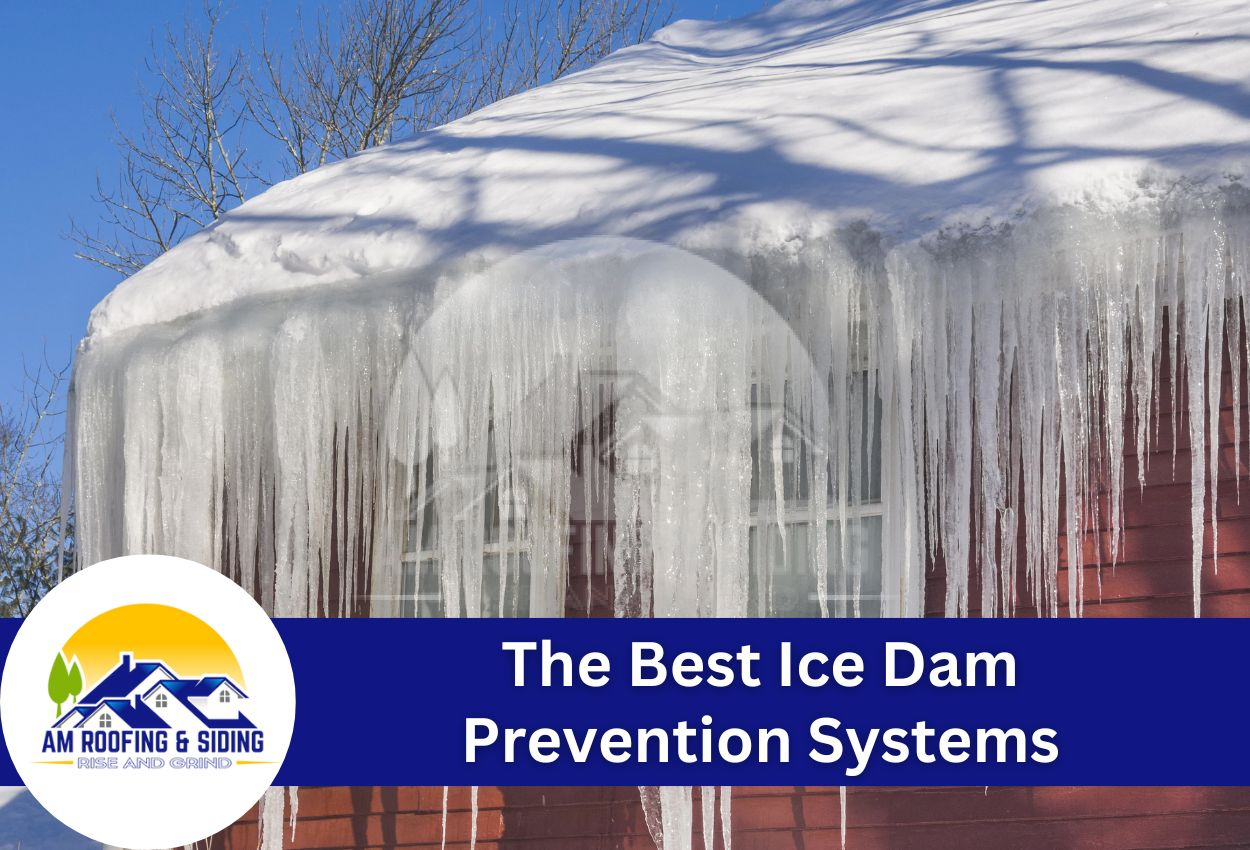As winter approaches, homeowners face the perennial challenge of ice dams, a common yet hazardous phenomenon that can significantly damage roofs. Understanding the importance of implementing effective ice dam prevention systems is crucial for maintaining the integrity of your home. Ice dams occur when heat from inside your home causes snow on the roof to melt. The water then refreezes as it reaches the colder edges of the roof, forming a barrier of ice that traps subsequent meltwater. The resulting water can leak into your home, causing damage to walls, ceilings, insulation, and other structural components.
Selecting the best ice dam prevention systems not only protects your residence from these winter woes but also preserves its long-term durability and value. Techniques such as installing heat cables for ice dams and understanding effective ice dam removal methods are essential components of a comprehensive ice dam strategy. This guide will explore how to stop ice dams on the roof effectively, ensuring your home remains dry and damage-free during the frosty months. Whether you’re installing new systems or optimizing existing solutions, knowing the right strategies can make all the difference.
Understanding Ice Dams and Their Impact on Roofs
Ice dams are thick ridges of solid ice that build up along the eaves of roofs. They form when melted snow from a warmer upper part of the roof refreezes as it reaches the colder lower sections. This cycle can create substantial barriers that prevent water from draining properly, leading to potential water infiltration into the roofing structure. In regions like Central Ohio, where winter temperatures frequently fluctuate above and below freezing, ice dams are a common issue.
The impact of ice dams on roofing systems can be severe. Water that backs up behind the dam can leak into a home and cause damage to walls, ceilings, and insulation. Over time, prolonged exposure to moisture can weaken the structural integrity of the roof, leading to costly repairs. For homeowners, understanding how to stop ice dams on the roof is essential. Techniques such as installing heat cables for ice dams or improving attic insulation and ventilation can be effective preventative measures. Additionally, using ice dam solutions for homes, including regular removal of snow from the roof, can help mitigate these risks.
It is important to address ice dams promptly and effectively to protect your home from water damage and to maintain the longevity of your roof. Employing professional services for installing heat cables for ice dams or for effective ice dam removal methods can ensure your roofing system is prepared to handle the challenges of winter weather safely and efficiently.
Comprehensive Review of Ice Dam Prevention Technologies
Exploring modern technologies for preventing ice dams is essential for homeowners seeking to safeguard their roofs from winter damage. The best ice dam prevention systems include various technological solutions tailored to stop ice buildup efficiently. These technologies range from simple heat cables to more advanced heating panels and edge melt systems designed specifically for ice dam prevention.
Heat cables, commonly referred to as heating tapes, are installed along the edges of the roof and in the gutters. These cables heat up during cold weather to prevent snow from freezing into ice, mitigating the formation of ice dams. While heat cables are an effective solution, they must be installed correctly to function properly. On the other hand, advanced systems like heated panels provide a more uniform heat distribution, which can be more effective but also more expensive.
When comparing the effectiveness of these systems, it’s crucial to consider factors such as installation complexity, energy consumption, cost, and the specific needs of your home. For instance, installing heat cables for ice dams is more straightforward and cost-effective, making it a popular choice among homeowners. However, for those in areas with severe winter conditions, more robust systems like heated panels might offer better long-term protection.
Ultimately, selecting the right ice dam prevention technology depends on your home’s specific requirements and your budget. Consulting with a professional, especially those familiar with the weather patterns of Central Ohio, can help determine the most effective system to keep your home safe and dry throughout the winter season.
Homeowner’s Guide to Installing Heat Cables
Installing heat cables is a proactive step towards preventing ice dams on roofs, especially in areas prone to severe winter conditions like Central Ohio. Below are instructions on how to effectively install heat cables, ensuring your roof is equipped to prevent ice dams and the potential damage they cause.
First, ensure the roof is clean and free of debris. Mount the heat cables along the roof’s edge where ice dams typically form. It’s crucial to lay the cables in a zigzag pattern across the eaves to maximize coverage. Use clips and spacers provided with the cables to secure them without damaging the roof shingles.
Next, route the cables through the gutters and downspouts. This helps maintain an open channel for meltwater to flow down, preventing water from backing up and forming ice dams. Ensure that all parts of the cable are properly secured to avoid sagging or damage due to heavy snow.
Connect the cables to a power source equipped with a ground fault circuit interrupter (GFCI) for safety. It is advisable to hire a professional electrician for this step to ensure all electrical connections are safe and comply with local building codes.
Finally, test the system before the winter season begins to ensure it is functioning correctly. Turn on the heat cables during a cold day to check that they are warming up as expected.
Maintaining your heat cables is also essential for their longevity and effectiveness. Regularly inspect the cables for any signs of wear or damage and clear any debris from the roof, gutters, and downspouts to ensure optimal performance. By following these steps, homeowners can effectively utilize one of the best ice dam prevention systems to safeguard their homes.
Alternative Ice Dam Solutions for Homes
While heat cables are a popular choice for preventing ice dams, there are several non-heat cable solutions that homeowners can consider. These alternatives include improving attic insulation, enhancing roof ventilation, and regularly removing snow from the roof. Proper attic insulation helps maintain a consistent temperature across the roof’s surface, preventing the melting-and-freezing cycle that leads to ice dam formation. Enhanced ventilation allows cold air to circulate and keeps the roof’s temperature uniform.
Additionally, removing snow from the roof with a roof rake can prevent excessive accumulation, which often contributes to ice dam development. This manual method is labor-intensive but effective in reducing the risk of ice dams, especially after heavy snowfall. For homeowners in Central Ohio, where winters can be unpredictable, combining these methods can significantly enhance the effectiveness of ice dam prevention strategies.
The benefits of integrating multiple ice dam prevention methods are significant. Using a combination of solutions—such as installing heat cables along with improving insulation and ventilation—can provide a more comprehensive defense against ice dams. This multi-faceted approach not only minimizes the risk of ice dam formation but also contributes to overall energy efficiency and the long-term health of the roof.
Homeowners should assess their specific needs and consider consulting with roofing professionals to determine the most effective combination of ice dam prevention methods. This ensures both immediate and long-term protection against the potentially damaging effects of ice dams on roofs.
Evaluating the Best Ice Dam Prevention System for Your Home
Choosing the best ice dam prevention system requires careful consideration of several factors. Cost, ease of installation, and effectiveness are crucial elements to weigh. The right system not only fits your budget but also aligns with the architectural specifics of your home and the climatic conditions of Central Ohio. For instance, installing heat cables for ice dams might be less expensive and easier to install compared to more advanced systems like automated heat panels.
When evaluating different ice dam solutions for homes, consulting with roofing professionals who understand local weather patterns and roofing materials is beneficial. These experts can offer personalized advice based on the specific challenges your roof might face during winter. They can help determine if simple methods, like upgrading insulation, are sufficient or if more comprehensive solutions are needed to ensure effective ice dam removal and prevention.
Moreover, it’s important to consider the long-term implications of each option. While initial costs may be higher for some systems, they might offer better protection and durability, reducing the need for frequent repairs or replacements. Engaging with knowledgeable professionals can guide you through the complexities of various systems, helping you make an informed decision that safeguards your home from the adverse effects of ice dams.
Preventive Maintenance and Regular Care Tips
Routine checks and ongoing maintenance are crucial for enhancing the longevity of the best ice dam prevention systems. Regularly inspecting these systems, especially before the winter season, ensures they function optimally to prevent ice dam formation on your roof. Homeowners should clear any debris from the gutters and downspouts, check for any signs of wear or damage on heat cables, and ensure that all components are securely attached and functioning properly.
Seasonal tips are also vital for maintaining the peak performance of ice dam prevention systems throughout the winter. It is crucial to monitor the system during the winter months, particularly after heavy snowfall or ice storms.
Protect Your Home with AM Roofing & Siding’s Expert Ice Dam Prevention Systems
Don’t let ice dams wreak havoc on your roof this winter. Safeguard your home with the best ice dam prevention systems offered by AM Roofing & Siding. Our proven technologies and expert installation services ensure your roof stays secure and damage-free. Reach out to us today at (740) 974-8268 to schedule a consultation and take the first step toward a worry-free winter. Trust AM Roofing & Siding for reliable solutions that keep ice dams at bay and your home protected.

